Integrating Business, Social, and Environmental Goals in Open Innovation through Partner Selection
Abstract
:1. Introduction
2. Literature Review
2.1. Collaboration Networks and Partner Selection: An Introduction
2.2. Partner Selection by Using Multicriteria Decision-Making (MCDM) Approaches
3. Proposed Approach
3.1. Adopted Criteria
- Economic: Concerns all the criteria that might impact the CN’s economic and financial viability, which includes issues mainly related with the organization’s economic wellbeing [15], namely, facility location [37,42,56], supply chain channels (distribution points, transportation modes, etc.) [42], scale (available) of operations [56,69], operation costs [75,76], financial situation and credibility [37], capacity of facilities [42], and reliability of feedstock supply [15], among other criteria.
- Social: Concerns all the criteria that might impact the CN’s social viability, which can include issues mainly related with the organization’s social wellbeing with their stakeholders as well as reputation and share of knowledge/information issues [23], i.e., social responsibility actions (e.g., employees’ family members, health insurance, local population, etc.) [42], work conditions [23], availability to share knowledge and information [70], knowledge relevance, reputation, and number of partnerships firmed with other organizations [71], among other criteria.
- Environmental: Concerns all the criteria that might impact the CN’s environmental viability [15], which includes issues mainly related with the organization’s environmental responsibility [75], namely, self-energy greenhouse gas (GHG) emissions [15,40,73], soil and water quality [40], circular economy policies [67], and environment standards accreditation [15,73], among other criteria.
3.2. Problem Formulation
3.3. Model Architecture
- Fuzzification—used to modify the inputs to be analyzed and compared with the rules, originated from the rule-base module.
- Inference mechanism—used to assess which decision rules are important at a given instant time, in order to further decide what should be the decision to be performed.
- “Rule-base”—holds the based knowledge, materialized on a set of rules on how perform the best decisions.
- Defuzzification—converts the main conclusions achieved by the inference engine/mechanism into a series of decisions regarding partner selection.
3.4. Fuzzy Deployment
4. Case Study, Results, and Discussion
5. Conclusions
Author Contributions
Funding
Institutional Review Board Statement
Informed Consent Statement
Data Availability Statement
Conflicts of Interest
References
- Prahalad, C.K.; Hamel, G. The core competence of the corporation. Harvard Bus. Rev. 2010, 68, 275–292. [Google Scholar]
- Wang, L.; Wang, X.; Philipsen, N.J. Network structure of scientific collaborations between China and the EU member states. Scientometrics 2017, 113, 765–781. [Google Scholar] [CrossRef] [PubMed] [Green Version]
- Weitzman, M.L. Recombinant growth. Q. J. Econ. 1998, 113, 331–360. [Google Scholar] [CrossRef]
- Amabile, T.M. Social psychology of creativity: A consensual assessment technique. J. Pers. Soc. Psychol. 1982, 43, 997–1013. [Google Scholar] [CrossRef]
- Amabile, T.M.; Conti, R.; Coon, H.; Lazenby, J.; Herron, M. Assessing the work environment for creativity. Acad. Manag. J. 1996, 39, 1154–1184. [Google Scholar]
- Hsu, M.L.A.; Chen, F.H. The cross-level mediating effect of psychological capital on the organizational innovation climate-employee innovative behavior relationship. J. Creat. Behav. 2017, 51, 128–139. [Google Scholar] [CrossRef]
- Perry-Smith, J.E. Social yet creative: The role of social relationships in facilitating individual creativity. Acad. Manag. J. 2006, 49, 85–101. [Google Scholar] [CrossRef]
- Gonzalez-Brambila, C.N.; Veloso, F.; Krackhardt, D. The impact of network embeddedness on research output. Res. Policy 2013, 42, 1555–1567. [Google Scholar] [CrossRef]
- Liao, C.H. How to improve research quality? Examining the impacts of collaboration intensity and member diversity in collaboration networks. Scientometrics 2011, 86, 747–761. [Google Scholar] [CrossRef]
- Andersen, K.V. The problem of embeddedness revisited: Collaboration and market types. Res. Policy 2013, 42, 139–148. [Google Scholar] [CrossRef]
- Zhou, T.; Lü, L.; Zhang, Y.-C. Predicting missing links via local information. Eur. Phys. J. B 2009, 71, 623–630. [Google Scholar] [CrossRef] [Green Version]
- Lotf, J.J.; Azgomi, M.A.; Dishabi, M.R.E. An improved influence maximization method for social networks based on genetic algorithm. Phys. A Stat. Mech. Appl. 2022, 586, 126480. [Google Scholar] [CrossRef]
- Wi, H.; Oh, S.; Mun, J.; Jung, M. A team formation model based on knowledge and collaboration. Expert Syst. Appl. 2009, 36, 9121–9134. [Google Scholar] [CrossRef]
- Bozzon, A.; Brambilla, M.; Ceri, S.; Silvestri, M.; Vesci, G. Choosing the right crowd: Expert finding in social networks. In Proceedings of the ACM International Conference on Extending Database Technology, Genoa, Italy, 18–22 March 2013; pp. 637–648. [Google Scholar]
- Santos, R.; Abreu, A.; Soares, J.; Mendes, F.M.A.S.; Calado, J.M. A Soft Computing Framework to Support Consumers in Obtaining Sustainable Appliances from the Market. Appl. Sci. 2020, 10, 3206. [Google Scholar] [CrossRef]
- Abreu, A.; Martins, J.D.M.; Calado, J.M.F. Fuzzy Logic Model to Support Risk Assessment in Innovation Ecosystems. In Proceedings of the 2018 13th APCA International Conference on Control and Soft Computing (CONTROLO), Ponta Delgada, Portugal, 4–6 June 2018; pp. 104–109. [Google Scholar]
- Ávila, P.; Mota, A.; Pires, A.; Bastos, J.; Putnik, G.; Teixeira, J. Supplier’s selection model based on an empirical study. Procedia Technol. 2012, 5, 625–634. [Google Scholar] [CrossRef] [Green Version]
- Tsai, K.-H. Collaborative networks and product innovation performance: Toward a contingency perspective. Res. Policy 2009, 38, 765–778. [Google Scholar] [CrossRef]
- Emden, Z.; Calantone, R.J.; Droge, C. Collaborating for new product development: Selecting the partner with maximum potential to create value. J. Prod. Innov. Manag. 2020, 23, 330–341. [Google Scholar] [CrossRef]
- Zolghadri, M.; Eckert, C.; Zouggar, S.; Girard, P. Power-based supplier selection in product development projects. Comput. Ind. 2011, 62, 487–500. [Google Scholar] [CrossRef]
- Rajesh, R.; Ravi, V. Supplier selection in resilient supply chains: A grey relational analysis approach. J. Clean. Prod. 2015, 86, 343–359. [Google Scholar] [CrossRef]
- Kraljic, P. Purchasing must become supply management. Harv. Bus. Rev. 1983, 61, 109–117. [Google Scholar]
- Junior, F.R.L.; Osiro, L.; Carpinetti, L.C.R. A comparison between fuzzy AHP and Fuzzy TOPSIS methods to supplier selection. Appl. Soft Comput. 2014, 21, 194–209. [Google Scholar] [CrossRef]
- Kaya, T.; Kahraman, C. Multicriteria decision making in energy planning using a modified fuzzy TOPSIS methodology. Expert Syst. Appl. 2011, 38, 6577–6585. [Google Scholar] [CrossRef]
- Abdullah, L.; Najib, L. Sustainable energy planning decision using the intuitionistic fuzzy analytic hierarchy process: Choosing energy technology in Malaysia. Int. J. Sustain. Energy 2014, 35, 360–377. [Google Scholar] [CrossRef]
- Kannan, D.; Khodaverdi, R.; Olfat, L.; Jafarian, A.; Diabat, A. Integrated fuzzy multi criteria decision making method and multiobjective programming approach for supplier selection and order allocation in a green supply chain. J. Clean. Prod. 2013, 47, 355–367. [Google Scholar] [CrossRef]
- Yue, Z. TOPSIS-based group decision-making methodology in intuitionistic fuzzy setting. Inf. Sci. 2014, 277, 141–153. [Google Scholar] [CrossRef]
- Büyüközkan, G.; Çifçi, G.; Güleryüz, S. Strategic analysis of healthcare service quality using fuzzy AHP methodology. Expert Syst. Appl. 2011, 38, 9407–9424. [Google Scholar] [CrossRef]
- Xu, Z.; Liao, H. Intuitionistic Fuzzy Analytic Hierarchy Process. IEEE Trans. Fuzzy Syst. 2014, 22, 749–761. [Google Scholar] [CrossRef]
- Chesbrough, H. The future of open innovation. Res. Manag. 2017, 60, 35–38. [Google Scholar] [CrossRef]
- Du, J.; Leten, B.; Vanhaverbeke, W. Managing open innovation projects with science-based and market-based partners. Res. Policy 2014, 43, 828–840. [Google Scholar] [CrossRef]
- Albats, E.; Alexander, A.; Mahdad, M.; Miller, K.; Post, G. Stakeholder management in SME open innovation: Interdependences and strategic actions. J. Bus. Res. 2020, 119, 291–301. [Google Scholar] [CrossRef]
- Chistov, V.; Aramburu, N.; Carrillo-Hermosilla, J. Open eco-innovation: A bibliometric review of emerging research. J. Clean. Prod. 2021, 311, 127627. [Google Scholar] [CrossRef]
- Fetterhoff, T.J.; Voelkel, D. Managing Open Innovation in Biotechnology. Res. Manag. 2006, 49, 14–18. [Google Scholar] [CrossRef]
- Huizingh, E.K. Open innovation: State of the art and future perspectives. Technovation 2011, 31, 2–9. [Google Scholar] [CrossRef]
- Kirschbaum, R. Open innovation in practice. Res.-Technol. Manag. 2015, 48, 24–28. [Google Scholar] [CrossRef]
- Slowinski, G.; Sagal, M.W. Good Practices in Open Innovation. Res. Manag. 2010, 53, 38–45. [Google Scholar] [CrossRef]
- Bilgram, V.; Füller, J.; Bartl, M.; Biel, S.; Miertsch, H. Eine Allianz gegen Flecken. Harv. Bus. Manag. 2013, 35, 62–68. [Google Scholar]
- Gassmann, O. Crowdsourcing–Innovations Management Mit Schwarmintelligenz: Interaktiv Ideen Finden; Kollektives Wissen Effektiv Nutzen; Mit Fallbeispielen und Checklisten, 2. Aufl; Carl Hanser: München, Germany, 2013. [Google Scholar]
- Echterhoff, N. Systematik zur Planung Von Cross-Industry-Innovationen. Ph.D. Dissertation, Verlagshaus Monsenstein und Vannerdat OHG, München, Germany, 2014. [Google Scholar]
- Van Beers, C.; Zand, F. R&D cooperation, partner diversity, and innovation performance. An empirical analysis. J. Prod. Innov. Manag. 2014, 31, 292–312. [Google Scholar]
- West, J.; Bogers, M. Leveraging External Sources of Innovation: A Review of Research on Open Innovation. J. Prod. Innov. Manag. 2014, 31, 814–831. [Google Scholar] [CrossRef]
- Giannopoulou, E.; Yström, A.; Ollila, S. Turning open innovation into practice: Open innovation research through the lens of managers. Int. J. Innov. Manag. 2011, 15, 505–524. [Google Scholar] [CrossRef]
- Lazzarotti, V.; Visconti, F.; Pellegrini, L.; Gjergji, R. Are there any differences between family and non-family firms in the open innovation era? Lessons from the practice of European manufacturing companies. Int. J. Technol. Intell. Plan. 2017, 11, 279. [Google Scholar] [CrossRef]
- Laursen, K.; Salter, A. The paradox of openness: Appropriability, external search and collaboration. Res. Policy 2014, 43, 867–878. [Google Scholar] [CrossRef] [Green Version]
- Bengtsson, L.; Lakemond, N.; Lazzarotti, V.; Manzini, R.; Pellegrini, L.; Tell, F. Open to a select few? Matching partners and knowledge content for open innovation performance. Creat. Innov. Manag. 2014, 24, 72–86. [Google Scholar] [CrossRef] [Green Version]
- Markovic, S.; Bagherzadeh, M. How does breadth of external stakeholder co-creation influence innovation performance? Analyzing the mediating roles of knowledge sharing and product innovation. J. Bus. Res. 2018, 88, 173–186. [Google Scholar] [CrossRef]
- Solesvik, M.Z.; Gulbrandsen, M. Partner selection for Open Innovation. Technol. Innov. Manag. Rev. 2013, 3, 11–16. [Google Scholar] [CrossRef]
- Lopez-Vega, H.; Tell, F.; Vanhaverbeke, W. Where and how to search? Search paths in open innovation. Res. Policy 2016, 45, 125–136. [Google Scholar] [CrossRef]
- Vanhaverbeke, W. Managing Open Innovation in SMEs; Cambridge University Press: Cambridge, UK, 2017. [Google Scholar]
- Aloini, D.; Dulmin, R.; Farina, G.; Mininno, V.; Pellegrini, L. Structured selection of partners in open innovation: An IF-TOPSIS based approach. Meas. Bus. Excell. 2016, 20, 53–66. [Google Scholar] [CrossRef]
- Guertler, M.R.; Lindemann, U. Identifying Open Innovation partners: A methodology for strategic partner selection. Int. J. Innov. Manag. 2016, 20, 1640011. [Google Scholar] [CrossRef]
- Von Hippel, E.; Franke, N.; Prügl, R. Efficient Identification of Leading-Edge Expertise. Screening vs. Pyramiding. In Proceedings of the PICMET Conference: Technology Management for the Global Future, Istanbul, Turkey, 8–13 July 2016; pp. 884–897. [Google Scholar]
- Newmeyer, C.; Venkatesh, R.; Chatterjee, R. Cobranding arrangements and partner selection: A conceptual frame-work and managerial guidelines. J. Acad. Mark. Sci. 2014, 42, 103–118. [Google Scholar] [CrossRef]
- Belz, F.-M.; Baumbach, W. Netnography as a method of lead user identification. Creat. Innov. Manag. 2010, 19, 304–313. [Google Scholar] [CrossRef]
- Yoon, B.; Song, B. A systematic approach of partner selection for open innovation. Ind. Manag. Data Syst. 2014, 114, 1068–1093. [Google Scholar] [CrossRef]
- Tojeiro-Rivero, D.; Moreno, R. Technological cooperation, R&D outsourcing, and innovation performance at the firm level: The role of the regional context. Res. Policy 2019, 48, 1798–1808. [Google Scholar] [CrossRef]
- Hossain, M. A review of literature on open innovation in small and medium-sized enterprises. J. Glob. Entrep. Res. 2015, 5, 6. [Google Scholar] [CrossRef] [Green Version]
- Poetz, M.K.; Prügl, R. Crossing domain-specific boundaries in search of innovation. Exploring the potential of pyramiding. J. Prod. Innov. Manag. 2010, 27, 897–914. [Google Scholar] [CrossRef]
- Su, W.; Huang, S.X.; Fan, Y.S.; Mak, K.L. Integrated partner selection and production–distribution planning for manufacturing chains. Intell. Enterp. Syst. 2015, 84, 32–42. [Google Scholar] [CrossRef]
- Meige, A.; Golden, B. Multistep dynamic expert sourcing: A novel approach for open Innovation platforms. In A Guide to Open Innovation and Crowdsourcing: Practical Tips Advice and Examples from Leading Experts in the Field; Sloane, P., Ed.; Kogan Page: London, UK; Philadelphia, PA, USA, 2011; Volume 23, pp. 189–196. [Google Scholar]
- Chen, Y. A study on the modes of open innovation matched with firms’ internal capabilities. In Proceedings of the International Conference on Management of Engineering & Technology (PICMET), Kanazawa, Japan, 27–31 July 2014. [Google Scholar]
- Zhang, G.; Wang, X.; Duan, H.; Zheng, L.J. How do new entrants’ pre-entry technological backgrounds impact their cross-industry innovation performances? A retrospective study of the mobile phone vendors. Technovation 2021, 100, 102176. [Google Scholar] [CrossRef]
- Jeppesen, L.B.; Lakhani, K.R. Marginality and Problem-Solving Effectiveness in Broadcast Search. Organ. Sci. 2010, 21, 1016–1033. [Google Scholar] [CrossRef] [Green Version]
- Hernandez-Vivanco, A.; Cruz-Cázares, C.; Bernardo, M. Openness and management systems integration: Pursuing innovation benefits. J. Eng. Technol. Manag. 2018, 49, 76–90. [Google Scholar] [CrossRef]
- Gassmann, O.; Daiber, M.; Enkel, E. The role of intermediaries in cross-industry innovation processes. R&D Manag. 2011, 41, 457–469. [Google Scholar] [CrossRef]
- Lin, L.; Yuan, X.-H.; Xia, Z.-Q. Multicriteria fuzzy decision-making methods based on intuitionistic fuzzy sets. J. Comput. Syst. Sci. 2007, 73, 84–88. [Google Scholar] [CrossRef] [Green Version]
- Boran, F.E.; Boran, K.; Menlik, T. The evaluation of renewable energy technologies for electricity generation in Turkey using intuitionistic fuzzy TOPSIS. Energy Sources Part B Econ. Plan. Policy 2012, 7, 81–90. [Google Scholar] [CrossRef]
- Joshi, D.; Kumar, S. Intuitionistic fuzzy entropy and distance measure based TOPSIS method for multi-criteria decision making. Egypt. Inform. J. 2014, 15, 97–104. [Google Scholar] [CrossRef]
- Dias, A.S.M.E.; Abreu, A.; Navas, H.V.G.; Santos, R. Proposal of a Holistic Framework to Support Sustainability of New Product Innovation Processes. Sustainability 2020, 12, 3450. [Google Scholar] [CrossRef] [Green Version]
- Santos, R.; Abreu, A.; Dias, A.; Calado, J.; Anes, V.; Soares, J. A Framework for Risk Assessment in Collaborative Networks to Promote Sustainable Systems in Innovation Ecosystems. Sustainability 2020, 12, 6218. [Google Scholar] [CrossRef]
- Guertler, M.R.; Sick, N. Exploring the enabling effects of project management for SMEs in adopting open innovation—A framework for partner search and selection in open innovation projects. Int. J. Proj. Manag. 2021, 39, 102–114. [Google Scholar] [CrossRef]
- Uren, V.; Miller, T.; Da Campo, R.; Dadzie, A.-S. A model for partner selection criteria in energy from waste projects. J. Clean. Prod. 2021, 279, 123582. [Google Scholar] [CrossRef]
- Li, E.Y.; Liao, C.H.; Yen, H.R. Co-authorship networks and research impact: A social capital perspective. Res. Policy 2013, 42, 1515–1530. [Google Scholar] [CrossRef]
- Abreu, A.; Santos, R.; Calado, J.; Requeijo, J. A Fuzzy Logic Model to Enhance Quality Management on R&D Units. KnE Eng. 2020, 5, 285–298. [Google Scholar] [CrossRef]
- Santos, R.; Abreu, A.; Anes, V. Developing a Green Product-Based in an Open Innovation Environment. Case Study: Electrical Vehicle. In Collaborative Networks and Digital Transformation; Camarinha-Matos, L., Afsarmanesh, H., Antonelli, D., Eds.; IFIP Advances in Information and Communication Technology; Springer: Cham, Switzerland, 2019; Volume 568. [Google Scholar]
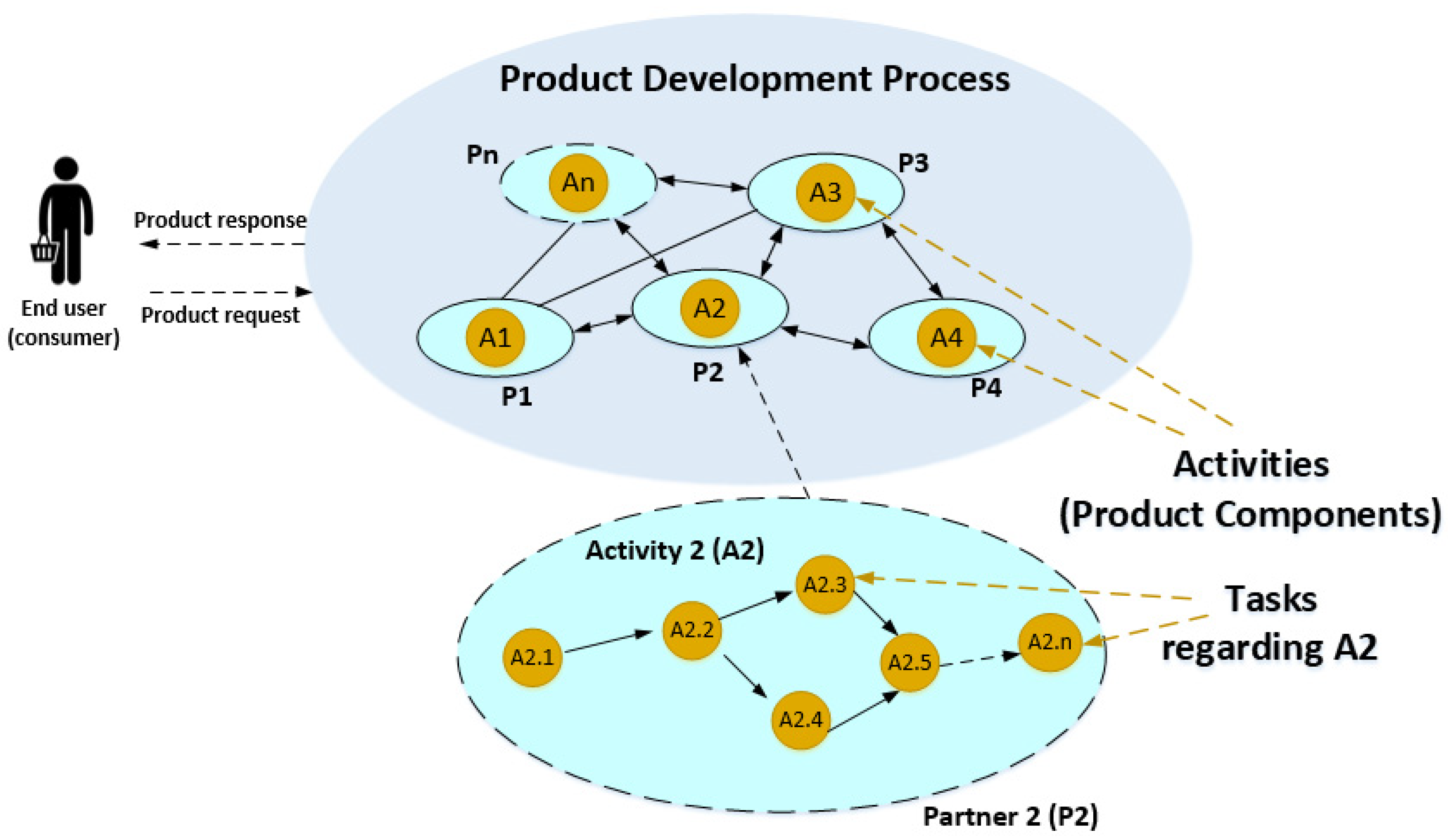

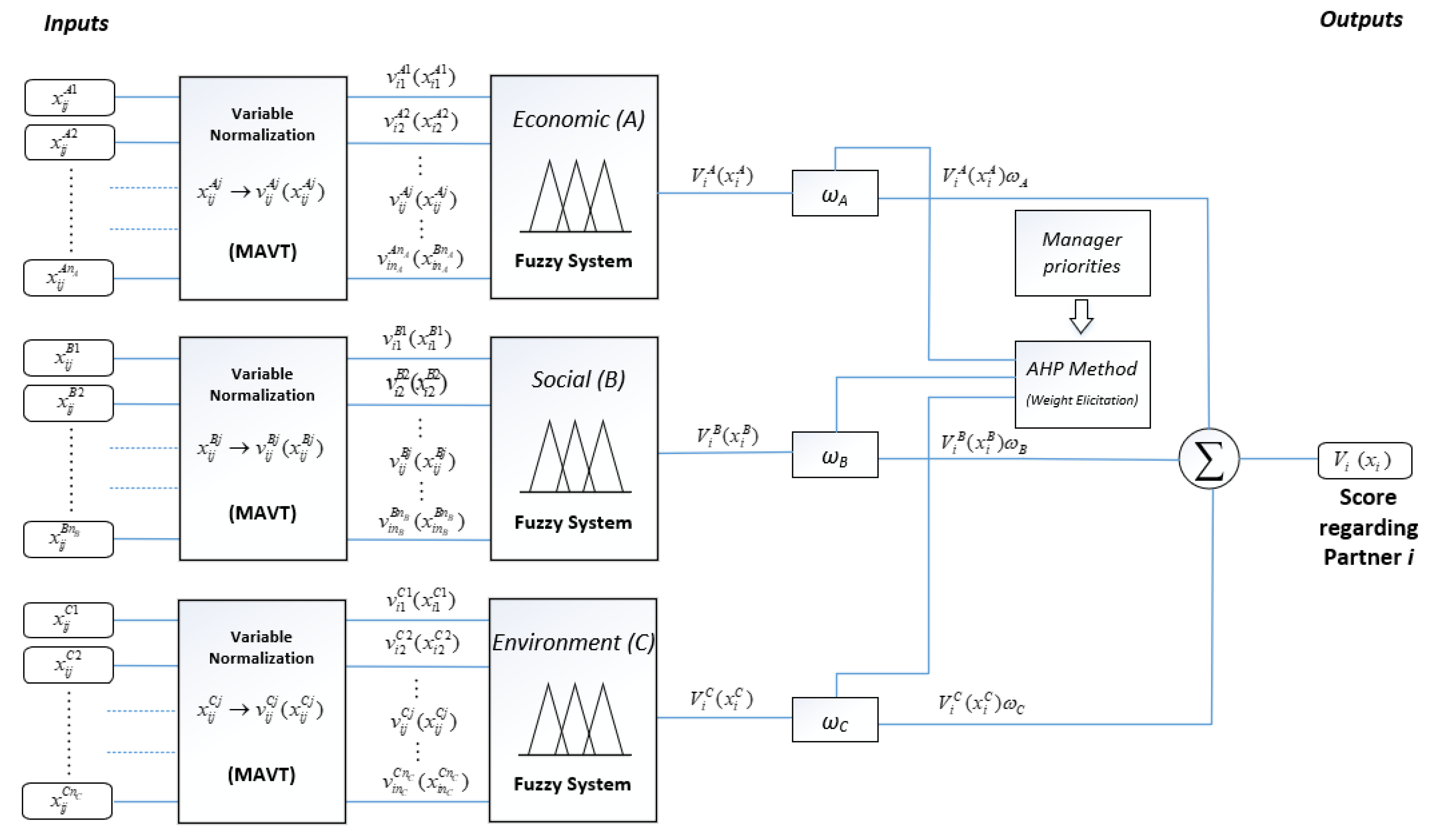
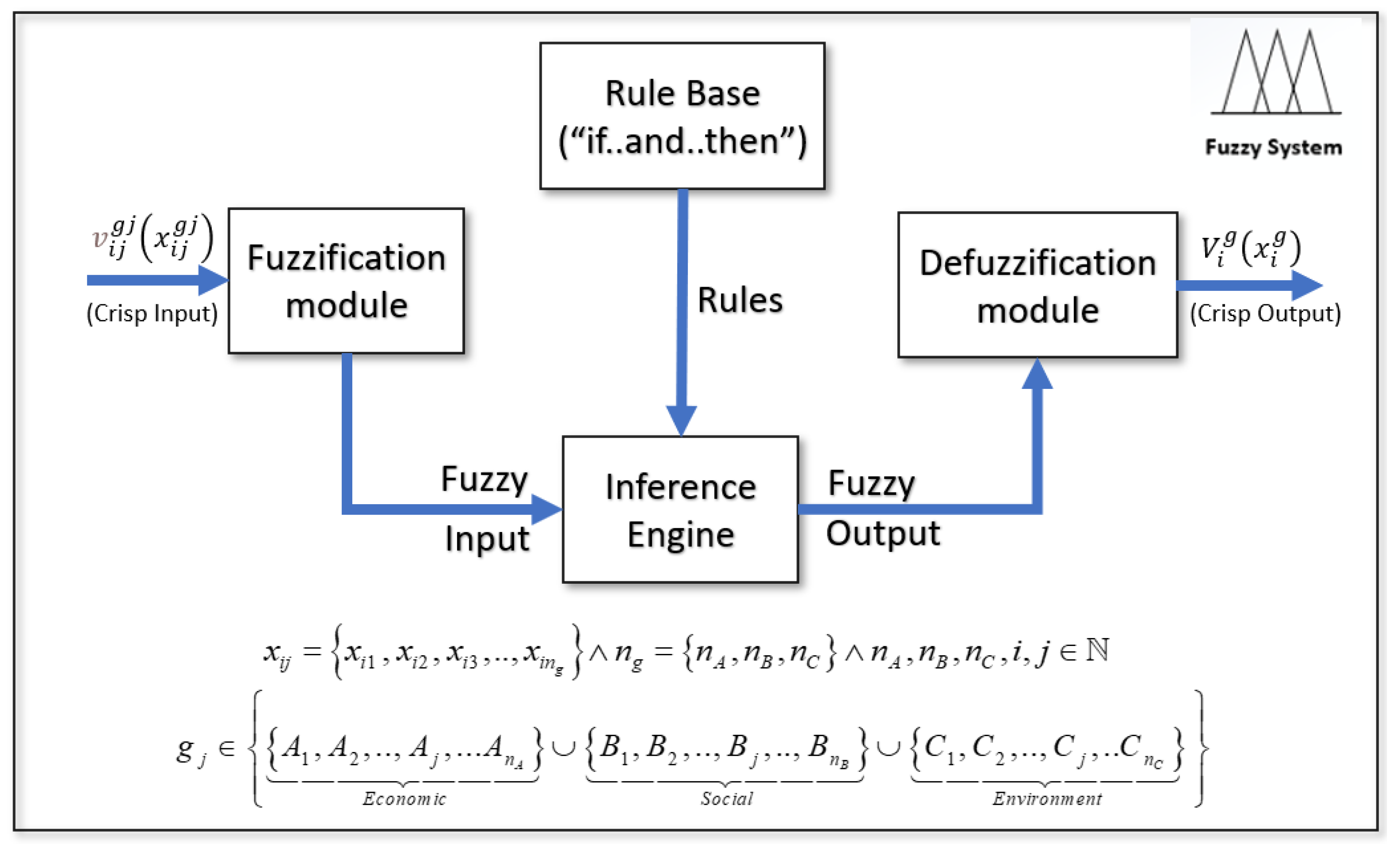
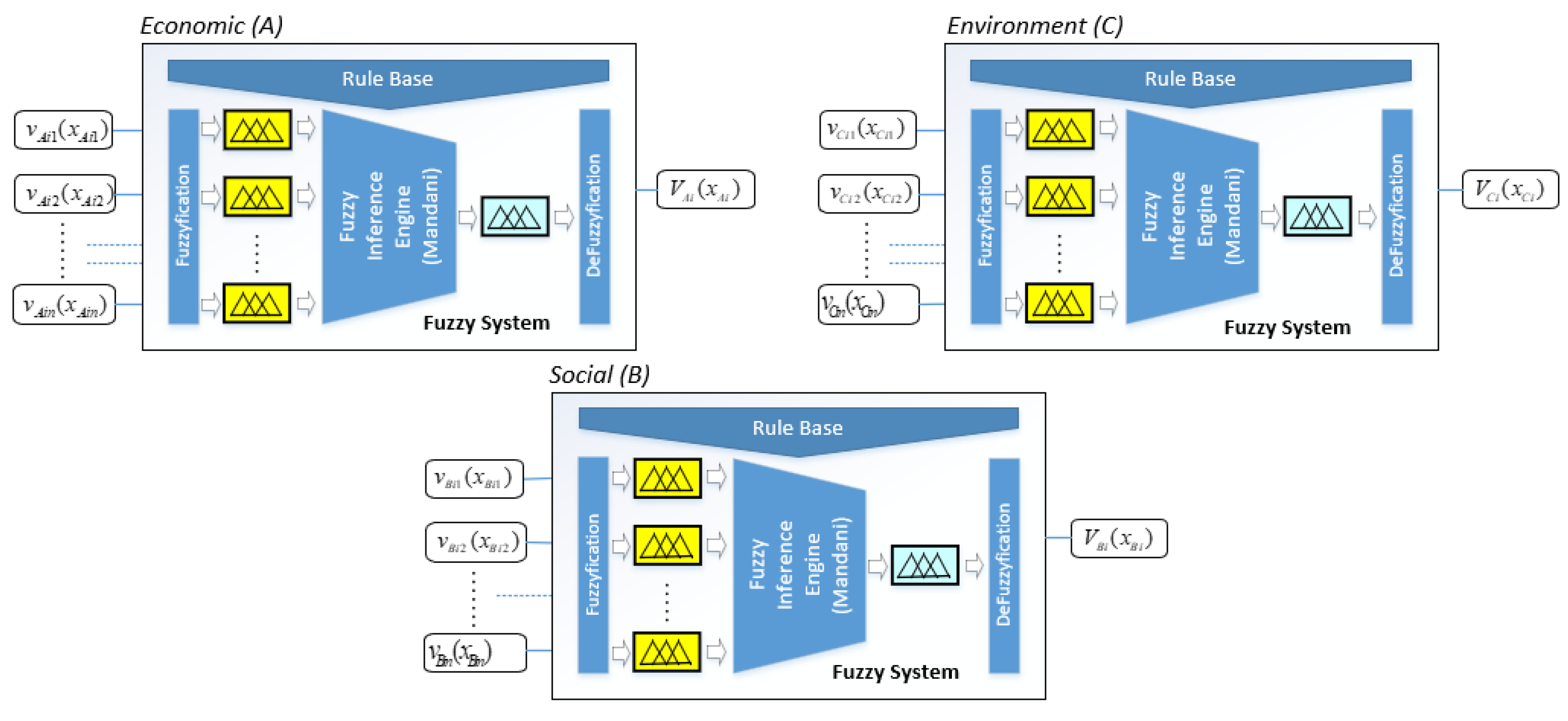

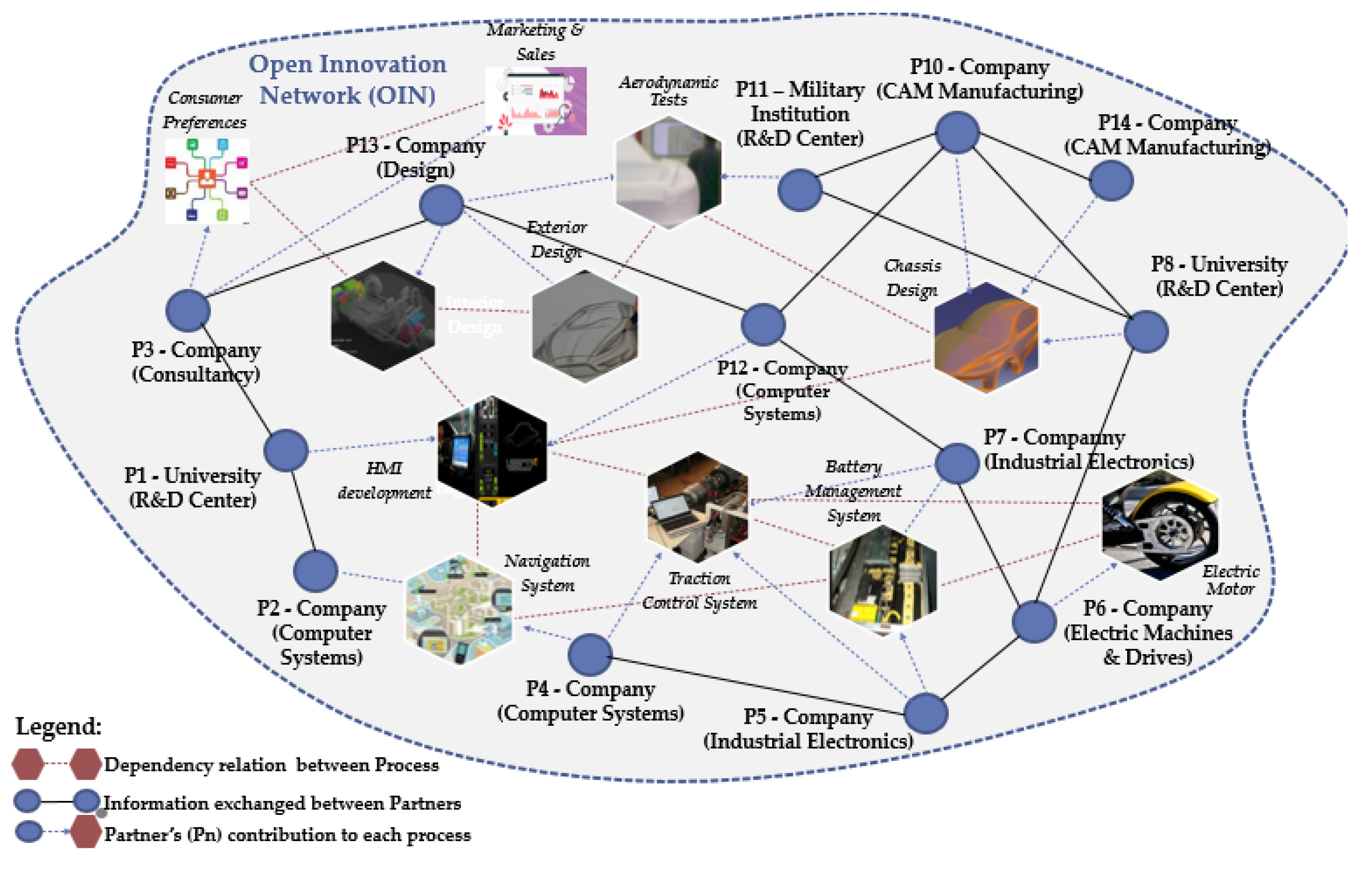

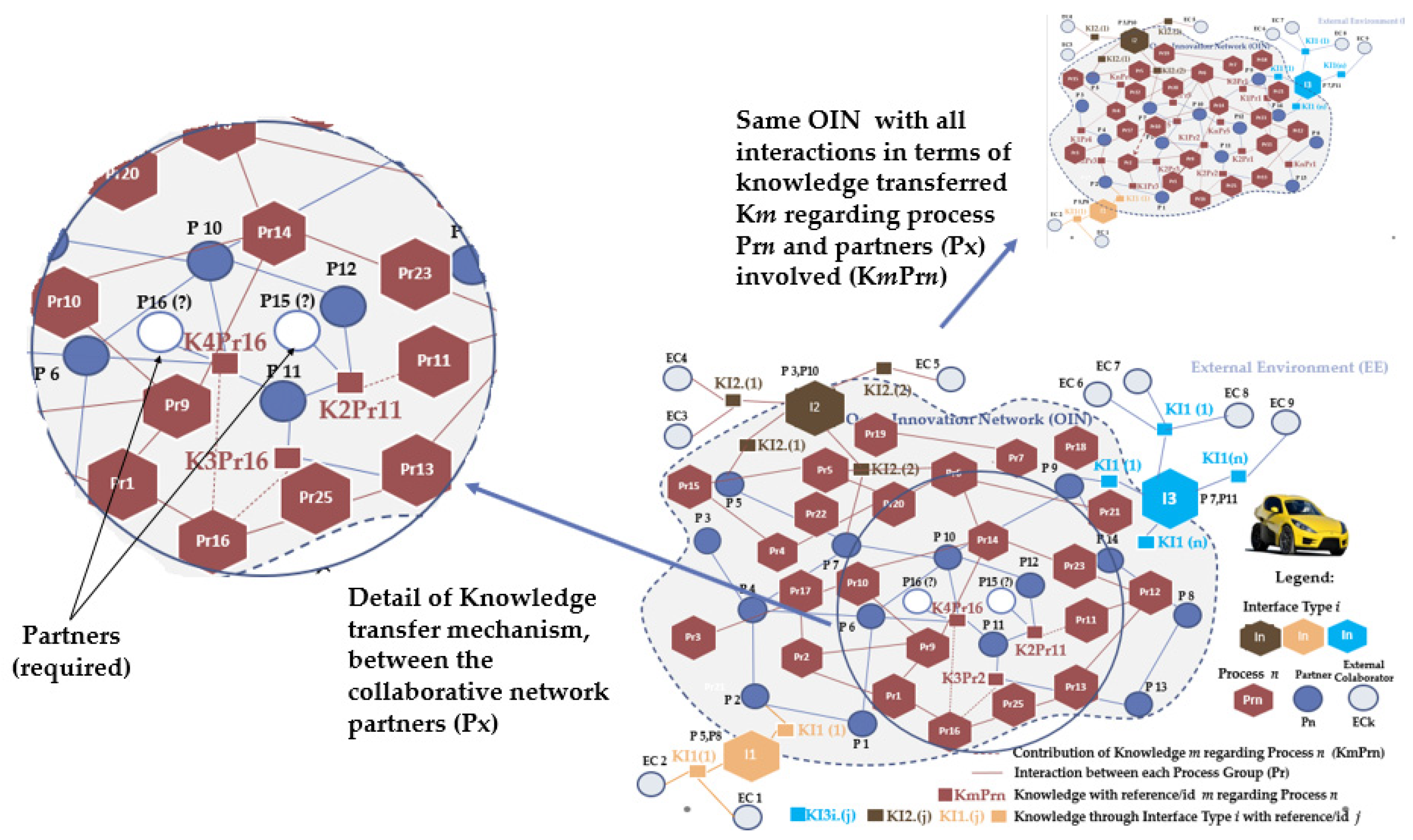
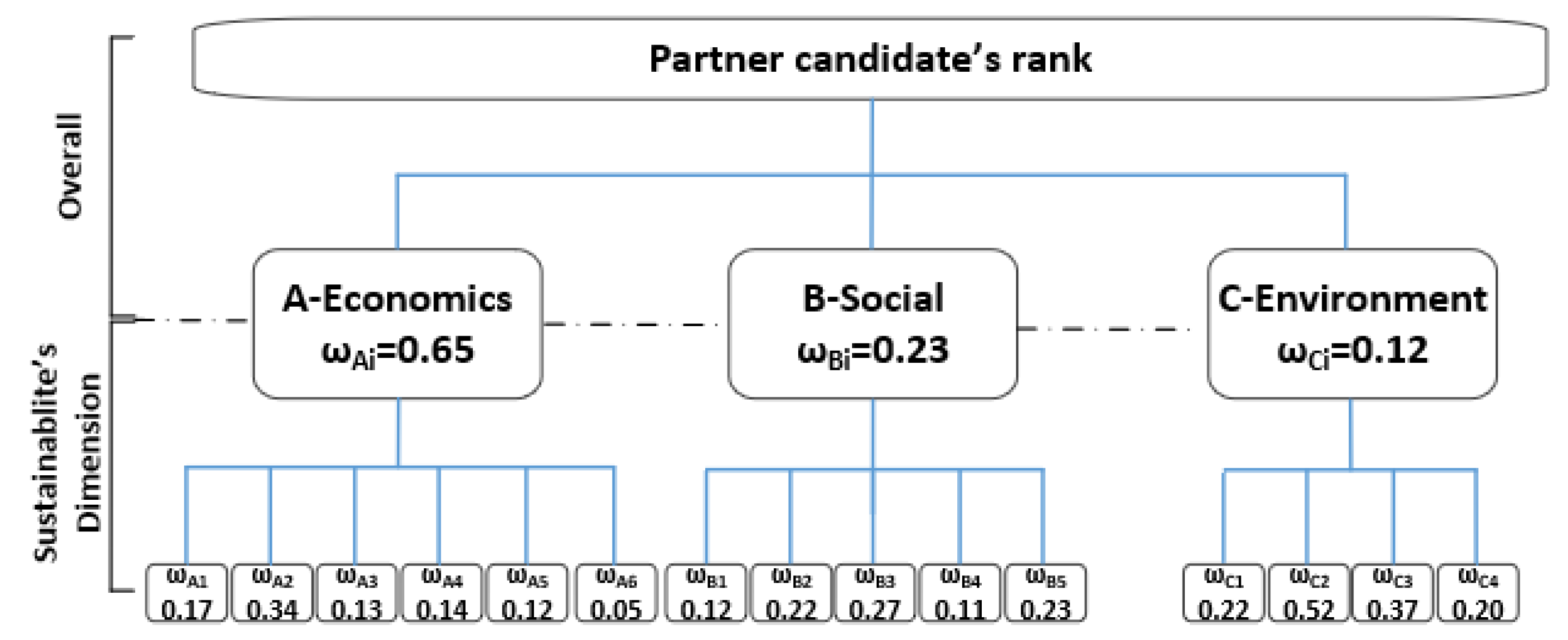
| Criteria | Attributes/Score | 0% | 25% | 50% | 75% | 100% | |||||||||||||||||||||
|---|---|---|---|---|---|---|---|---|---|---|---|---|---|---|---|---|---|---|---|---|---|---|---|---|---|---|---|
| Subcriteria | Not Preferable | Low Preferable | Reasonable Preferable | Preferable | Highly Preferable | ||||||||||||||||||||||
| A—Economics | Finance situation and credibility | ||||||||||||||||||||||||||
| Available assets | |||||||||||||||||||||||||||
| Facility’s location | |||||||||||||||||||||||||||
| Supply chain’s channels | |||||||||||||||||||||||||||
| Scale (available) of operations | |||||||||||||||||||||||||||
| Operation costs | |||||||||||||||||||||||||||
| Total | 0 | 5 | 10 | 15 | 20 | 25 | 30 | 35 | 40 | 45 | 50 | 55 | 60 | 65 | 70 | 75 | 80 | 85 | 90 | 95 | 100 | ||||||
| B—Social | Company’s Reputation (Transparency and legal requirements) | ||||||||||||||||||||||||||
| Knowlege relevance | |||||||||||||||||||||||||||
| Work conditions | |||||||||||||||||||||||||||
| External available resources (social network) | |||||||||||||||||||||||||||
| Social responsibility | |||||||||||||||||||||||||||
| Total | 0 | 5 | 10 | 15 | 20 | 25 | 30 | 35 | 40 | 45 | 50 | 55 | 60 | 65 | 70 | 75 | 80 | 85 | 90 | 95 | 100 | ||||||
| C—Environment | Industry’s energy dependence level from fossil fuels | ||||||||||||||||||||||||||
| Compliance with legal requirements regarding environment | |||||||||||||||||||||||||||
| Circular economy policies | |||||||||||||||||||||||||||
| Environmental standards (accreditation) | |||||||||||||||||||||||||||
| Total | 0 | 5 | 10 | 15 | 20 | 25 | 30 | 35 | 40 | 45 | 50 | 55 | 60 | 65 | 70 | 75 | 80 | 85 | 90 | 95 | 100 | ||||||
| Total Score | 0 | 5 | 10 | 15 | 20 | 25 | 30 | 35 | 40 | 45 | 50 | 55 | 60 | 65 | 70 | 75 | 80 | 85 | 90 | 95 | 100 | ||||||
 | (a) |
 | (b) |
| Fuzzy Set | Membership Function | Parameters [φ, χ, ψ] |
|---|---|---|
| Not Preferable | The candidate does not accomplish at all this sub criterion | (0, 0, 0.25) |
| Low Preferable | The candidate somehow accomplishes this sub criterion | (0, 0.25, 0.50) |
| Reasonable Preferable | The candidate reasonably accomplishes this sub criterion | (0.25, 0.50, 0.75) |
| Preferable | The candidate seems to fulfill this criterion | (0.5, 0.75, 1.0) |
| Highly Preferable | The candidate fulfills this criterion | (0.75, 1, 1) |
| Fuzzy Set | Membership Function | Parameters [φ, χ, ψ] |
|---|---|---|
| Not Preferable | The candidate does not accomplish at all this criterion | (0, 0, 0.25) |
| Low Preferable | The candidate somehow accomplishes this criterion | (0, 0.25, 0.50) |
| Reasonable Preferable | The candidate reasonably accomplishes this criterion | (0.25, 0.50, 0.75) |
| Preferable | The candidate seems to fulfill this criterion | (0.5, 0.75, 1.0) |
| Highly Preferable | The candidate fulfills this criterion | (0.75, 1, 1) |
| Score | |
|---|---|
| Linguistic Levels | Numerical Correspondence |
| Not Preferable | [0, 0.2] |
| Low Preferable | [0.2, 0.4] |
| Reasonable Preferable | [0.4, 0.6] |
| Preferable | [0.6, 0.8] |
| Highly Preferable | [0.8, 1.0] |
| Process | Ref. | Activity | Ref. | Partners Involved |
|---|---|---|---|---|
| … | … | … | … | … |
| Marketing | [5] | Market studies | K01Pr5 | P8, P7 |
| Consumer’s requirements | K02Pr5 | P8, P7 | ||
| …. | … | … | ||
| Publicity | K4Pr5 | P3 | ||
| Human machine interface (HMI) | [8] | Software development | K01Pr8 | P6, P7 |
| PCB development and tests | K02Pr8 | P4, P9 | ||
| Electronic stability program (ESP) | [9] | System development | K01Pr9 | P2, (?) |
| Aerodynamics | [10] | Modelling studies | K01Pr10 | P14 |
| Prototype development | K02Pr10 | P5 | ||
| Aerodynamic Tests | K03Pr10 | P12 | ||
| GPS navigation system | [11] | Communications module | K01Pr11 | P2, P8 |
| Software development | K02Pr11 | P11, P12, P15(?) | ||
| Tests on site | K03Pr11 | P10 | ||
| … | … | … | … | … |
| Traction control system | [16] | Electronics | K01Pr16 | P9 |
| Interface with system’s BMS | K02Pr16 | P11, P12 | ||
| Interface with system’s ESP | K03Pr16 | P13, P11 | ||
| Electronics system’s interface with the electric motor | K04Pr16 | P6, P10, P11, P16 (?) | ||
| Tests | K05Pr16 | P11 | ||
| … | … | … | … | … |
| Battery management system (BMS) | [20] | System development | K01Pr20 | P2, P10 |
| System’s tests | K02Pr20 | P10 | ||
| … | … | … | … | … |
| Power converters | [25] | System development | K01Pr25 | P8, P11 |
| System’s tests | K02Pr25 | P10 |
| Process Reference | Partners (Required) | Partner (s) Candidate (s) | |
|---|---|---|---|
| Name | Organization | ||
| K02Pr11 | 3 partners Existing: P11, P12 Required: P15 | “A1” | Public—University |
| “B1” | Private—Company | ||
| “C1” | Private—University | ||
| “D1” | Private—Company | ||
| “E1” | Public—R&D Center | ||
| “F1” | Public—University | ||
| “G1” | Private—Company | ||
| “H1” | Public—University | ||
| “I1” | Public—University | ||
| Process Reference | Partners (Required) | Partner (s) Candidate (s) | |
|---|---|---|---|
| Name | Organization | ||
| K04Pr16 | 3 partners Existing: P06, P10 Required: P16 | “A2” | Private—University |
| “B2” | Private—Company | ||
| “C2” | Private—Company | ||
| “D2” | Public—University | ||
| “E2” | Private—R&D Center | ||
| “F2” | Public—R&D Center | ||
| “G2” | Private—Company | ||
| “H2” | Private—Company | ||
| Candidate’s Score | ||||||||||||||||||
|---|---|---|---|---|---|---|---|---|---|---|---|---|---|---|---|---|---|---|
| Candidate (s) | A—Economic | B—Social | C—Environmental | |||||||||||||||
| Name | ||||||||||||||||||
| “A1” | ||||||||||||||||||
| “B1” | ||||||||||||||||||
| “C1” | ||||||||||||||||||
| “D1” | ||||||||||||||||||
| “E1” | ||||||||||||||||||
| “F1” | ||||||||||||||||||
| “G1” | ||||||||||||||||||
| “H1” | ||||||||||||||||||
| “I1” | ||||||||||||||||||
| Legend: | Not Preferable | Low Preferable | Reasonable Preferable | Preferable | Highly Preferable ([0.8, 1.0]) | |||||||||||||
| ([0, 0.2]) | ([0.2, 0.4]) | ([0.4, 0.6]) | ([0.6, 0.8]) | |||||||||||||||
| Partner’s Score | ||||||||||||||||||
|---|---|---|---|---|---|---|---|---|---|---|---|---|---|---|---|---|---|---|
| Candidate (s) | A—Economic | B—Social | C—Environmental | |||||||||||||||
| Name | ||||||||||||||||||
| “A2” | ||||||||||||||||||
| “B2” | ||||||||||||||||||
| “C2” | ||||||||||||||||||
| “D2” | ||||||||||||||||||
| “E2” | ||||||||||||||||||
| “F2” | ||||||||||||||||||
| “G2” | ||||||||||||||||||
| “H2” | ||||||||||||||||||
| Legend: | Not Preferable | Low Preferable | ReasonablePreferable | Preferable | Highly Preferable ([0.8, 1.0]) | |||||||||||||
| ([0.0, 0.2]) | ([0.2, 0.4]) | ([0.4, 0.6]) | ([0.6, 0.8]) | |||||||||||||||
| Partner Candidates (Rank) | Partner Candidates (Ordered Rank) | ||||||||||||
|---|---|---|---|---|---|---|---|---|---|---|---|---|---|
| Name | Organization | ωAi | ωBi | ωCi | PSn | Name | Organization | PSn | |||||
| “A1” | Public—University | 0.15 | 0.25 | 0.23 | 0.65 | 0.23 | 0.12 | 0.18 | “D1” | Private—Company | 0.66 | ||
| “B1” | Private—Company | 0.39 | 0.22 | 0.67 | 0.65 | 0.23 | 0.12 | 0.38 | “I1” | Public—University | 0.64 | ||
| “C1” | Private—University | 0.57 | 0.52 | 0.22 | 0.65 | 0.23 | 0.12 | 0.52 | “E1” | Public—R&D Center | 0.55 | ||
| “D1” | Private—Company | 0.72 | 0.49 | 0.67 | 0.65 | 0.23 | 0.12 | 0.66 | “C1” | Private—University | 0.52 | ||
| “E1” | Public—R&D Center | 0.48 | 0.65 | 0.70 | 0.65 | 0.23 | 0.12 | 0.55 | “G1” | Private—Company | 0.50 | ||
| “F1” | Public—University | 0.12 | 0.39 | 0.17 | 0.65 | 0.23 | 0.12 | 0.17 | “H1” | Public—University | 0.45 | ||
| “G1” | Private—Company | 0.57 | 0.23 | 0.62 | 0.65 | 0.23 | 0.12 | 0.50 | “B1” | Private—Company | 0.38 | ||
| “H1” | Public—University | 0.42 | 0.49 | 0.57 | 0.65 | 0.23 | 0.12 | 0.45 | “A1” | Public—University | 0.18 | ||
| “I1” | Public—University | 0.68 | 0.50 | 0.69 | 0.65 | 0.23 | 0.12 | 0.64 | “F1” | Public—University | 0.17 | ||
| Preference degree: | 1st | 2nd | 3rd | 4th | 5th | ||||||||
| Partner Candidates (Rank) | Partner Candidates (Ordered Rank) | |||||||||||||||
|---|---|---|---|---|---|---|---|---|---|---|---|---|---|---|---|---|
| Name | Organization | ωAi | ωBi | ωCi | PSn | Name | Organization | PSn | ||||||||
| “A2” | Private—University | 0.71 | 0.41 | 0.22 | 0.65 | 0.23 | 0.12 | 0.58 | “D2” | Pubic—University | 0.79 | |||||
| “B2” | Private—Company | 0.52 | 0.24 | 0.35 | 0.65 | 0.23 | 0.12 | 0.44 | “A2” | Private—University | 0.58 | |||||
| “C2” | Private—Company | 0.58 | 0.33 | 0.51 | 0.65 | 0.23 | 0.12 | 0.51 | “E2” | Private—R&D Center | 0.59 | |||||
| “D2” | Pubic—University | 0.90 | 0.71 | 0.32 | 0.65 | 0.23 | 0.12 | 0.79 | “C2” | Private—Company | 0.51 | |||||
| “E2” | Private—R&D Center | 0.58 | 0.61 | 0.59 | 0.65 | 0.23 | 0.12 | 0.59 | “H2” | Private—Company | 0.48 | |||||
| “F2” | Public—R&D Center | 0.18 | 0.49 | 0.37 | 0.65 | 0.23 | 0.12 | 0.27 | “B2” | Private—Company | 0.44 | |||||
| “G2” | Private—Company | 0.45 | 0.27 | 0.23 | 0.65 | 0.23 | 0.12 | 0.38 | “G2” | Private—Company | 0.38 | |||||
| “H2” | Private—Company | 0.52 | 0.42 | 0.37 | 0.65 | 0.23 | 0.12 | 0.48 | “F2” | Public—R&D Center | 0.27 | |||||
| Preference degree: | 1st | 2nd | 3rd | 4th | 5th | |||||||||||
Publisher’s Note: MDPI stays neutral with regard to jurisdictional claims in published maps and institutional affiliations. |
© 2021 by the authors. Licensee MDPI, Basel, Switzerland. This article is an open access article distributed under the terms and conditions of the Creative Commons Attribution (CC BY) license (https://creativecommons.org/licenses/by/4.0/).
Share and Cite
Santos, R.S.; Soares, J.; Marques, P.C.; Navas, H.V.G.; Martins, J.M. Integrating Business, Social, and Environmental Goals in Open Innovation through Partner Selection. Sustainability 2021, 13, 12870. https://doi.org/10.3390/su132212870
Santos RS, Soares J, Marques PC, Navas HVG, Martins JM. Integrating Business, Social, and Environmental Goals in Open Innovation through Partner Selection. Sustainability. 2021; 13(22):12870. https://doi.org/10.3390/su132212870
Chicago/Turabian StyleSantos, Ricardo S., Jose Soares, Pedro Carmona Marques, Helena V. G. Navas, and José Moleiro Martins. 2021. "Integrating Business, Social, and Environmental Goals in Open Innovation through Partner Selection" Sustainability 13, no. 22: 12870. https://doi.org/10.3390/su132212870
APA StyleSantos, R. S., Soares, J., Marques, P. C., Navas, H. V. G., & Martins, J. M. (2021). Integrating Business, Social, and Environmental Goals in Open Innovation through Partner Selection. Sustainability, 13(22), 12870. https://doi.org/10.3390/su132212870









